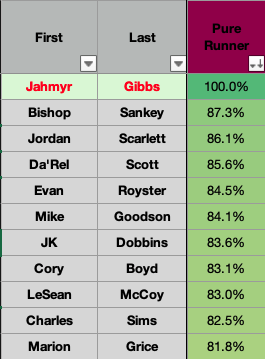This article is part of a series in which I evaluate current college running backs solely on their ability to run the ball. I previously did the same sort of analysis focused on the 2022 rookie running back class, and you can find those articles, as well as explanations of my methodology, here and here. Otherwise, feel free to skip to the player-focused analysis below.

Alabama’s Jahmyr Gibbs spent the first two years of his college career at Georgia Tech. There, he posted seasonal Dominator Ratings in the 92nd and 62nd-percentiles, respectively (among backs drafted since 2007). He also caught 59 passes in 19 games as an underclassman; proving to be one of the most prolific and dynamic receiving backs we’ve seen recent years.
Let’s see how his performance on the ground stacks up to that impressive production and pass-catching ability:
The Metrics
On relatively subdued volume at just over 12 carries per game with the Yellow Jackets, Jahmyr Gibbs totaled 1,206 rushing yards while averaging 5.2 yards per carry in each campaign. Relative to the other backs at Georgia Tech, who averaged a collective 3.11-star rating as high school recruits (pedigree in the 47th-percentile), Gibbs wasn’t exactly impressive.
While seeing an average of 0.14 fewer defenders in the box on his carries than his teammates faced on theirs (a 21st-percentile discrepancy), Gibbs managed to outdo those other backs by just 0.08 yards per carry. That YPC+ mark lands in just the 32nd percentile. He also barely outperformed them in 10-yard run rate. His 0.6-percent Chunk Rate+ is a 46th-percentile mark.
Once he reaches the second level on his relatively infrequent chunk gains, Gibbs has been pretty good. He’s converted his 10-yard runs into breakaways of 20 yards or more at a 33.3-percent clip. This Breakaway Conversion Rate lands him in the 61st-percentile.
Given the box counts he’s seen, the average carry for Gibbs has been worth 105.1-percent the output of the average carry from all non-Gibbs runners at Georgia Tech in the last two years. He’s producing positively on a per-carry basis, but not to an impressive degree. That Box-Adjusted Efficiency Rating is in just the 24th-percentile.
More Context
Sometimes you see dynamic runners who produce efficiently overall while not showing play-to-play consistency. Sometimes you get the opposite, guys who produce positive outcomes and avoid negative plays on a consistent basis while not boasting high overall efficiency numbers due to a lack of juice in creating big plays. Jahmyr Gibbs doesn’t fit in either of those buckets through two years. His Relative Success Rate, which is a consistency metric that measures his rate of positive runs relative to his teammates and given the box counts he faces, is a 32nd-percentile mark of -0.8-percent.
So, Gibbs succeeded on a lower share of his runs than other Georgia Tech backs did. And given the box counts he was seeing, he barely outproduced them on a per-touch basis. These aren’t encouraging signs from a guy who is supposed to be an elite player in the vaunted 2023 running back class.
Rushing Efficiency Score and Comps
My process combines percentile scores in the above metrics (in addition to adjustments for overall team quality and strength of opponent) to generate composite scores that quantify a player’s overall rushing efficiency profile. In my process’ main composite, Jahmyr Gibbs earns a 29.4 out of 100.
Using the same metrics that go into those rushing efficiency composites (in addition to physical measurables), I am also able to generate similarity scores between current and past prospects as a way of formulating comps. Using historical height and weight data for eventual NFL running backs, I project Gibbs to be 5-10 and 208-pounds at his eventual Combine weigh-in. If he runs a 4.45 40-yard dash at that size, the following players will be his 10 closest comps from a “pure runner” perspective:

LeSean McCoy was obviously a fantastic pure runner for a long time. But he averaged 0.92 yards per carry greater than his teammates at Pitt. That’s a far cry from Gibbs outdoing his backfield mates by 0.08. Another optimistic (but more realistic) comp is J.K. Dobbins; an explosive player in a situation suited to his strengths in Baltimore after he also failed to impress on the ground relative to his teammates in college. The rest of this list is packed with JAGs.
Last Word
Overall, Jahmyr Gibbs is one of the best receiving weapons we’ve seen at running back in recent memory. He’s also been a precocious producer. Hopefully he’s able to continue those things while improving upon his subpar rushing performance at Alabama next season. Currently, his numbers as a pure runner do not match the hype he’s getting in devy and forward-looking dynasty circles.


